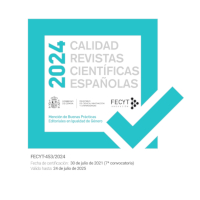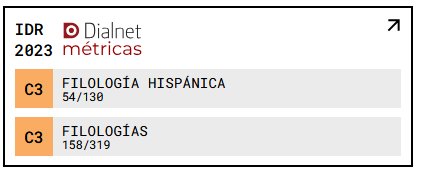Genre and Stylistic Originality of Kazakh Poetry of the First Half of the Twentieth Century
DOI:
https://doi.org/10.18172/cif.6323Keywords:
national liberation movement, philosophical issues, the originality of versification, Kazakh poetry, nomadic poetryAbstract
The purpose of the article is to study the uniqueness of Kazakh poetry in the context of world poetry, considering the Kazakh people as a separate ethnic group with a certain mentality and traditions, taking into account the peculiarities of nomadic poetry and its further influence on the development of literature. The fundamental methods for the study of this problem are the method of analysis, within the framework of which there is a selection and study of individual parts of the phenomenon in order to identify the uniqueness of Kazakh poetry, as well as the method of comparison, with the help of which it is possible to identify and qualitatively assess the trends of Kazakh poetry of the first half of the twentieth century in comparison with other centuries. Literature is the science that absorbs external environmental factors and beautifully reflects them on paper, which will help to competently analyse and cope with life's difficulties and problems. The very study of the originality of the genre and style of Kazakh poetry is aimed at educating and raising the level of culture of students within the framework of the program for educational institutions, and in general has enlightening and educational functions.
Downloads
References
Abril, J. C. (2025). Culture Efficacy: An Alternative to Collective Efficacy. Review of Law and Social Sciences, 3(1), 155-177. DOI: https://doi.org/10.71261/rlss/31.155.177
Altai, A. D., and Aituganova, S. S. (2019). Features of Kazakh literature in the XV-XVIII centuries. International Academy Journal Web of Scholar, 7(37), 25-33.
Altybaeva, S. M. (2018). Казахская проза периода независимости: традиция, новаторство, перспективы [Kazakh prose of the period of independence: Tradition, innovation, prospects]. Gylym.
Asankulova, B. S. (2012). Motives of moral and legal education in the work of Kazakh zhyrau. In Pedagogical skills: Materials of the I International Scientific Conference (pp. 362-363). Buki-Vedi.
Beisebayev, A. (1992). Национальное и интернациональное в современной Казахской поэзии: (60-80 годы) [National and international in modern Kazakh poetry (60-80 years)]. Thesis for the degree of PhD in Philological Sciences. Kazakh National University.
Belger, G. (2006). Spiritual shepherds of the nation. Thought, 3, 72-80.
Denys, I. (2024). Language as an important means of information encoding. Library Science. Record Studies. Informology, 20(1), 8-11. DOI: https://doi.org/10.63009/lsrsi/1.2024.08
Gaziev, I. M. (2008). The origin of professionalism in the musical culture of the ancient Turks. Bulletin of the South Ural State Humanitarian and Pedagogical University, 12, 181-183.
Idelbaev, M. K. (2018). Professional improvisational creativity in the literature of Turkic authors. Bulletin of the North-Eastern Federal University named after M.K. Ammosov: Epic Series, 2, 5-9.
Kanapyanov, B. M. (2020). “Абай вдохнул в пространство души казахское самосознание…” [“Abai breathed Kazakh self-consciousness into the space of the soul...”]. Profile, 5, 2-4.
Kongyratbay, T. A. (2021). Some problems of ethnic study of the heroic epic. Eposovedenie, 24(4), 15-22. DOI: https://doi.org/10.25587/e4294-4960-9721-z
Kongyratbay, T. A. (2022). Once again about the epic heritage of KorKuT. Eposovedenie, 2022(2), 28-39. DOI: https://doi.org/10.25587/n8974-5171-2692-o
Koshekova, A. A., Alpysbay, S. E., and Chakenova, B. A. (2016). The emergence of zhyrau and its activities. Actual Problems of the Humanities and Natural Sciences, 3-2, 136-139.
Litvinenko, V. V., and Nazarova, O. V. (2001). Reader on Kazakh literature [Хрестоматия по казахской литературе]. Vzglyad.
Magauin, M. (1987). Песни степей [Songs of the steppes]. In Poetry of zhyrau. Poems of Kazakh poets of the XҮ-XҮІІІ centuries (pp. 6-10). Zhalyn.
Mamraev, B. (2020). Символизм в казахской литературе [Symbolism in Kazakh literature]. Sozvuchie.
Mukhametshina, R. F., and Galimullina, A. F. (2014). Inculcation of bimental personality in context of cultural dialogue. Middle – East Journal of Scientific Research, 20(12), 2135-2138.
Mukhametzyanova, L. K. (2012). Роль информанта носителя эпической традиции в книжных дастанах татар Поволжья в популяризации национального эпоса [The role of the informant of the bearer of the epic tradition in the book dastans of the Volga Tatars in the popularization of the national epos]. Bulletin of the Chuvash University, 2, 337-340.
Musabekov, E. (1984). Some stylistic features of modern Kazakh poetry. Kazakstai.
Nurgalieva, K. (2016). The main stages of the formation and development of ethnoinstrumentology in Kazakhstan. Kurmangazy Kazakh National Conservatory.
Orazbayeva, N. S. (2015). Национальная самобытность Казахстана в художественных и документальных текстах конца XIX - первой половины XX веков [The national identity of Kazakhstan in artistic and documentary texts of the late XIX – first half of the XX centuries]. Eurasian National University named after L.N. Gumilyov.
Pancer-Cybulska, E., and Zlenko, Ya. (2024). The history of archival affairs in different countries: A comparative analysisof structures and organisational methods. Society. Document. Communication, 9(4), 48-61.
Romaniuk, O., and Yavorska, L. (2022). Complimenting behaviour in young adults’ first impression scripts. Analele Universitatii din Craiova - Seria Stiinte Filologice, Lingvistica, 44(1-2), 168-187. DOI: https://doi.org/10.52846/aucssflingv.v44i1-2.58
Serikzhanova, A., Nurtazina, R., Serikzhanova, I., Bukharbay, B., and Taitorina, B. (2024). Evolving Political Cultures in Kazakhstan, Uzbekistan, and Kyrgyzstan: Trends and New Paradigms. Journal of Ethnic and Cultural Studies, 11(3), 1-24. DOI: https://doi.org/10.29333/ejecs/1914
Shashkina, G., Ibraeva, Z., Tussupova, A., Zhapanova, M., and Anichshenko, O. (2025). Flower Representations in the Lyrics of A.A. Fet. Open Cultural Studies, 9(1), 20250047. DOI: https://doi.org/10.1515/culture-2025-0047
Sheryazdanova, G., Nurtazina, R., Byulegenova, B., Serikzhanova, A., and Dzhunusova, A. (2024). Socioeconomic and Political Causes of Youth Radicalization during the January 2022 Events in Kazakhstan. Global Perspectives, 5(1), 120495. DOI: https://doi.org/10.1525/gp.2024.120495
Shynkaruk, V. (2024). Functional characteristics of interrogative discursive utterances. International Journal of Philology, 28(1), 6-15. DOI: https://doi.org/10.31548/philolog15(1).2024.01
Stadnik, O. (2024). Cultural and sociological studies: Interdisciplinary and transdisciplinary fields. Culture and Contemporaneity, 26(2), 30-38. DOI: https://doi.org/10.63009/cac/2.2024.30
Toktagazin, M. B., Turysbek, R. S., Ussen, A. A., Nurtazina, R. A., Korganbekov, B. S., and Hradziushka, A. A. (2016). Modern internet epistolary in information and media discourse. Mathematics Education, 11(5), 1305-1319.
Vakulyk, I. (2020). Peculiarities of poetic translations of neoclassic. International Journal of Philology, 24(4), 64-69.
Velyka, A., and Birillo, I. (2024). Innovative features of corporate identity development. Culture and Contemporaneity, 26(1), 76-86. DOI: https://doi.org/10.63009/cac/1.2024.76
Zhanabaev, K. (2016). Об особенностях развития казахской поэзии в XV-XVIII вв. Общая характеристика [On the peculiarities of the development of Kazakh poetry in the XV-XVIII centuries. General characteristics]. Scientific Notes of the Khujand State University named after academician B. Gafurov. Humanities, 2, 153-155.
Zhantasova, Z. T., Kulanova, S. Sh., Uten, A., Omarov, N. K., and Eltayeva Zh. K. (2020). Развитие казахской литературы в 19 веке [Development of Kazakh literature in the 19th century]. Bulletin of Science and Education, 9(87), 5-7.
Zharikbaev, K. B., and Kaliev, S. K. (1995). Антология педагогической мысли Казахстана [Anthology of the pedagogical thought of Kazakhstan]. Rauan.
Downloads
Published
How to Cite
Issue
Section
License
Copyright (c) 2025 Mukhit Kozhashev, Alua Temirbolat, Sovetkhan Tleubayev, Karlygash Aisultanova, Ardak Sargeltayeva

This work is licensed under a Creative Commons Attribution 4.0 International License.
The authors retain copyright of articles and authorize CIF the first publication. They are free to share and redistribute the article without obtaining permission from the publisher as long as they give appropriate credit to the editor and the journal.
Self-archiving is allowed too. In fact, it is recommendable to deposit a PDF version of the paper in academic and/or institutional repositories.
It is recommended to include the DOI number.
This journal is licensed under a Creative Commons Attribution 4.0 International License














